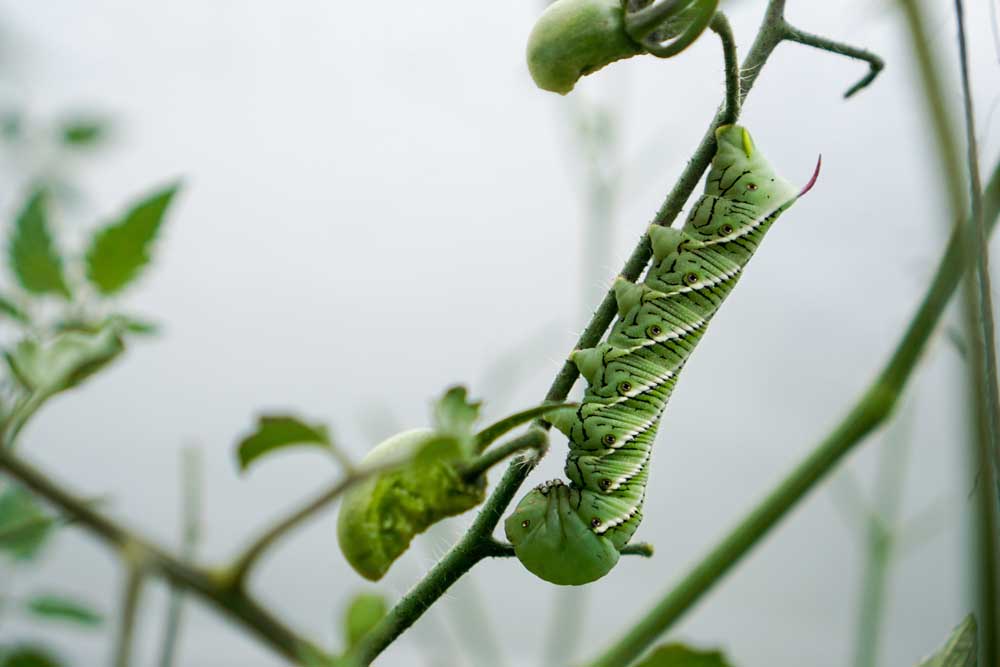Check tomato plants for hornworms while it’s hot
Published 12:00 am Sunday, August 4, 2019

- (Photo by 123RF)
The 85-degree-plus temperatures during the day and the warmer nights have finally pushed the growth button in my tomato patch. It’s time to start doing a morning routine of checking for the dreaded tomato hornworm.
The tomato hornworm looks like it is in the beginning growth stages of a prehistoric monster. Hornworms are among the largest caterpillars in North America. They are marked by having a horn on their hind side and markings down each side of their abdomen.
The hornworms are masters of camouflage. They perfectly match the bright green of tomato leaves. During the day, the 1- to 5-inch worm hides on the underside of the leaf or deep in the plant. They can rapidly denude the plant as well as eat into the green tomatoes. If you see telltale signs of their frass (black droppings) on the leaves it’s time to search and destroy. The control method is to handpick and destroy.
According to Whitney Cranshaw’s “Garden Insects of North America,” the adults are the “strong flying, heavy-bodied moths known as sphinx moths or hawk moths. Those that are active during the day are sometimes known as hummingbird moths.”
August is the time when tomato problems start showing up, so it is a good practice to take time every day and do a walkabout. Some of the common problems include tomato splitting, blossom end rot and catfacing (damage near the blossom end, such scarring and cavities).
Tomato splitting or fruit cracks are radial or concentric cracks on the stem end of ripening fruit and are caused by fluctuating soil-moisture levels. The solution is to mulch the plants to keep soil moisture constant and also reduce any fertilizer that has a high nitrogen content.
According to an Oregon State University fact sheet, blossom-end rot shows up as a large, gray to black spot at the blossom end of the fruit, the end opposite the stem. It affects green as well as ripe fruits. Brown discoloration at the blossom end may enlarge until they cover one-third to one-half of the surface. The tomato tissue becomes shrunken, and the surface of the spot becomes flattened or concave. The fundamental causes is deficiency of calcium in the plant and moisture stress. Excess nitrogen, magnesium, potassium or sodium may also contribute to the rot. The solution is to mulch the plants to maintain a constant moisture level and fertilize with a nitrogen side dressing only if necessary to maintain green color and moderate growth.
Catfacing sounds like a problem caused by the family pet. Black, scarred areas appear on the blossom end of misshapen tomatoes. The condition occurred from damage that happened weeks earlier when wind and low temperatures damaged the flower. Solution: Protect your plants from excessive winds, which may mean you have to change your planting area.
All gardeners will eventually face the fact that their plants are looking pretty ugly with chewed leaves, or curling yellow or brown leaves. The most common diseases are referred to as foliar diseases caused by fungus infections. Changing growing conditions and your practices are the most effective and least toxic solutions. Although the leaves look terrible, the developing fruit is generally fine.
I’m feeling lucky so far this year. All the plants in the various test plots on the property are holding their own, some plantings better than others. The plantings atop the concrete cistern in planting boxes are going ballistic, while the two varieties planted in-ground in a more open area are coming along. More to come as the ripe fruit makes its way to the dinner table.
Gardeners are fortunate to be able to identify insect pests and diseases with the usage of the “Pacific Northwest Insect Management Handbook” and the “Pacific Northwest Plant Disease Management Handbook,” both of which are available online.
— Reporter: douville@bendbroadband.com






